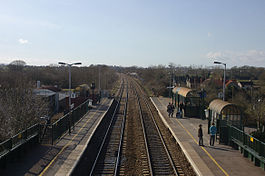- Nailsea and Backwell railway station
-
Nailsea and Backwell 

Looking westwards from the footbridge Location Place Backwell Local authority North Somerset Coordinates 51°25′10″N 2°45′01″W / 51.41952°N 2.75030°WCoordinates: 51°25′10″N 2°45′01″W / 51.41952°N 2.75030°W Operations Station code NLS Managed by First Great Western Number of platforms 2 Live arrivals/departures and station information
from National Rail EnquiriesAnnual rail passenger usage 2002/03 * 0.204 million 2004/05 *  0.239 million
0.239 million2005/06 *  0.268 million
0.268 million2006/07 *  0.296 million
0.296 million2007/08 *  0.344 million
0.344 million2008/09 *  0.380 million
0.380 millionHistory Original company Bristol and Exeter Railway Pre-grouping Great Western Railway Post-grouping Great Western Railway Opened 1841 National Rail - UK railway stations A B C D E F G H I J K L M N O P Q R S T U V W X Y Z * Annual passenger usage based on sales of tickets in stated financial year(s) which end or originate at Nailsea and Backwell from Office of Rail Regulation statistics. Please note: methodology may vary year on year. Nailsea and Backwell railway station is a station on the Bristol to Taunton Line. It is located in the village of Backwell and close to the town of Nailsea in North Somerset, England. The station is 8 miles (13 km) west of Bristol Temple Meads railway station.
Contents
History
The station was opened by the Bristol and Exeter Railway on 14 June 1841 as 'Nailsea'[1] and was the first station after leaving Bristol until Bedminster opened in 1871. When it was built it was surrounded by fields and served these rural communities, but both Nailsea and Backwell have expanded to accommodate commuters for Bristol and further afield since the 1970s. The main station buildings were provided on the Nailsea side of the station; Backwell has now spread right up to the railway line while the edge of Nailsea is still a little way distant to the north. Because of this, the station was renamed 'Nailsea and Backwell' on 1 May 1905. It reverted to plain Nailsea in 1974 but has been has since become 'Nailsea & Backwell' once again.[2]
Goods sidings were placed on the north side of the station, immediately west of the platforms[3]. A connection from these ran to the Nailsea Colliery, a long-closed outlying mine of the Somerset coalfield. Goods traffic ceased entirely from 1 June 1964.
Description
The station sits atop a bridge that spans the main road between Nailsea and Backwell. There is a car park on the Nailsea side of the station, and bus services from Nailsea to Backwell and Flax Bourton stop on the main road next to the car park.
Access to the two platforms is by steps from the road on either side; there is also a ramp leading up to the platform for trains towards Bristol. A small ticket kiosk on this platform was re-opened by the Severnside Rail Partnership in 2008, and 2 ticket machines are located under the platform. These are subject to frequent vandalism. There are waiting shelters on both platforms and even a footbridge between them, built by E. Finch and Company Ltd of Chepstow in 1907. There are "next train" monitors and an automated public address system to announce the trains.
The remains of the old station buildings can still be seen behind the shelters on Platform 2 (Bristol Bound) as well as from the taxi rank
Services
The station is managed and all trains are operated by First Great Western. The basic train service comprises two trains in each direction each hour. One train is the Bristol Parkway to Weston-super-Mare service that calls at all stations; the second is the faster Cardiff Central to Taunton service which runs non-stop between Bristol Temple Meads and Nailsea & Backwell. A similar stopping pattern is used by the peak period services to and from London Paddington. All trains call at Yatton, the next station westwards.
The typical journey time to Bristol Temple Meads is 11 minutes, while to London takes about two hours. The High Speed Trains used on the London services are longer than the station, and so passengers in the frontmost carriage have to go to a different carriage to disembark.
A morning eastbound CrossCountry service made a stop at the station to serve as a morning peak service, but this operation was dropped in the December 2008 timetable change. Instead, First Great Western now operates a loco-hauled set to replace this service. CrossCountry services still pass through the station, but none stop.
Preceding station  National Rail
National RailFollowing station Parson Street First Great Western
Bristol to Taunton LineYatton References
- ^ Oakley, Mike (2006). Somerset Railway Stations. Bristol: Redcliffe Press. ISBN 1-90453-754-5.
- ^ The Bristol Railway Archive
- ^ Cooke, RA (1979). Track Layout Diagrams of the GWR and BR WR, Section 16: West Somerset. Harwell: RA Cooke.
See also
Railway stations served by Bristol area commuter services Taunton to Bristol
and CardiffTaunton • Bridgwater • Highbridge and Burnham • Weston-super-Mare • Weston Milton • Worle • Yatton • Nailsea and Backwell • Parson Street • Bedminster • Bristol Temple Meads • Lawrence Hill • Stapleton Road • Filton Abbey Wood • Patchway • Pilning • Severn Tunnel Junction • Newport • Cardiff CentralWestbury and
Bristol to CheltenhamSevern Beach Line Railway stations in Somerset Bristol to London Paddington: Taunton to London Paddington: Exeter to London Waterloo: Taunton to Bristol: Taunton • Bridgwater • Highbridge and Burnham • Weston-super-Mare • Weston Milton • Worle • Yatton • Nailsea and BackwellWeymouth to Westbury:
Heart of Wessex lineHeritage RailwaysEast Somerset Railway: West Somerset Railway: Categories:- Railway stations in Somerset
- Former Great Western Railway stations
- Railway stations opened in 1841
- Railway stations served by First Great Western
- DfT Category F2 stations
Wikimedia Foundation. 2010.

